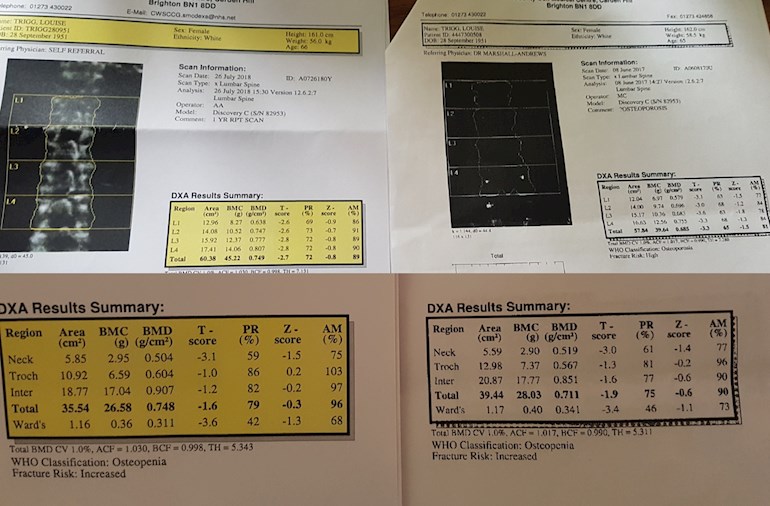I posted recently that I had had a second dexa scan a year after the first one (paid for privately at the same clinic). I was unsure why the results had improved with the exception of a small increase in my femoral neck. I had some questions to ask the NOS and am posting them here -
"Your results show a very slight change in the neck t-score (-3 to -3.1) and this change is very small. The change of -0.1 may reflect that you are a year older by the time the second scan was taken. We lose bone density very gradually over time, little by little. In addition as with any measuring device (repeat blood pressure monitoring being a good example) there is a possibility of precision error in the measurements because it’s extremely difficult to achieve identical positioning of the bones on scans being done the same day let alone a year or years apart. Technicians are trained to replicate positioning and DXA machines are regularly calibrated. There isn't a set national standard or the frequency of bone density scans. Scanning tends to vary greatly across the UK depending on the resources available, and the referrals made. Not all people will need to have repeat scans for the purpose of monitoring their osteoporosis, especially if they are settled on a drug treatment that suits them and they are stable and not having any fractures (broken bones)"
I then had a question about the difference in the results from QFracture and Frax (I hadn't had that point used Garvan) and so I asked them and here is their answer:
"QFracture will give a different result as it seperates out the type of fragility fracture a person has had and adds in fall risk etc. As you can see below from a quick try with your information (but I don’t know about your fracture) the results look much more benign and friendly and could indicate treatment based on different risk factors but they aren’t likely to be so accurate as when tailored to the DXA scan femoral neck t score reading. It would be hoped that both tools would indicate a higher fracture risk. However having had an osteoporotic (fragility fracture), either type of assessment tool is likely to suggest an increased fracture risk and that taking an osteoporosis medication is beneficial as it might reduce that risk by up to a half (average of 50%)."
I then followed up with further details of the 3 falls I have had in the past 18 months - The first happened when I was jogging on the promenade by the beach. I slipped on shingle that had been swept onto the ground. I broke my wrist and had surgery to repair it. In July I tripped on an uneven pavement and fell quite hard but didn't break anything. 6 weeks ago I tripped on another uneven pavement and had an occult fracture in my elbow (proximal radius) No treatment was required other than a foam sling and advice not to lift anything more than a cup of tea for the 6 weeks.
This is their response:
"It is common that when we're older (for women post menopausal) all of us might lose perhaps around 1 or 2% of bone density in a year and so it seems that a year after starting treatment and making lifestyle changes, your scan results are showing things are holding their own. This is encouraging, however bear in mind that it's a rapid snapshot of how effective these measures may be given more years, but all seems stable and most importantly with no new fractures which is the main aim alongside strengthening your bones."
I am attaching an image of both hip and spine scans from last year and this.
Hoping any of this might help or be of interest to anyone.
In the absence (here in the UK) of specialist advice or knowledgeable GPs, and without having to rely on Facebook forums, the NOS advice is very comprehensive, if not entirely positive in my case!
(Seems to be if we lose bone density over time as we age, then it all seems a bit hopeless and we may as well just enjoy life and cross our fingers!)


